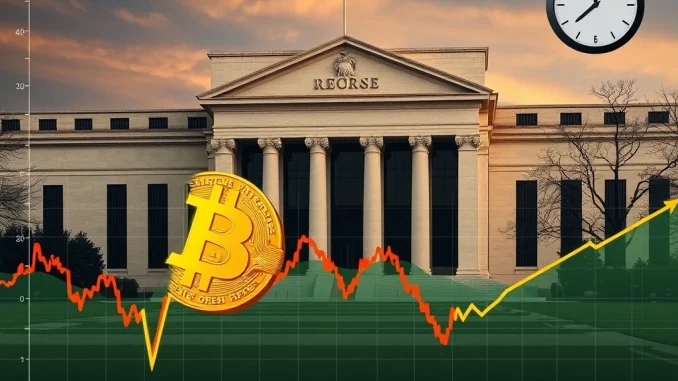
The cryptocurrency world is once again abuzz, and the latest headlines center on a familiar interplay: the Federal Reserve’s monetary policy and its immediate ripple effect on the Bitcoin price. As the Fed opted to hold interest rates steady, the leading digital asset saw a notable dip, underscoring the deep sensitivity of the crypto market to macroeconomic signals. For investors and enthusiasts alike, understanding this dynamic is crucial.
Why Did the Bitcoin Price React to the Federal Reserve’s Decision?
On July 25, 2025, the cryptocurrency landscape witnessed a significant reaction. The Bitcoin price experienced a 2.34% decline, falling below $116,000. This movement coincided directly with widespread expectations that the Federal Reserve would maintain its current interest rate policy at the upcoming July 30 FOMC meeting. CME Group’s “FedWatch” tool indicated a staggering 97.4% probability of no change, effectively telegraphing the decision to the markets.
But why does a decision to hold rates, rather than raise them, lead to a fall in Bitcoin’s value? The answer lies in market expectations and the forward-looking nature of financial assets. While a rate hold might seem neutral, the market is already pricing in future possibilities, specifically the potential for easing measures by September. The current dip suggests that some investors might have anticipated a more dovish tone or are rebalancing portfolios in anticipation of future shifts, leading to short-term volatility.
Understanding the Federal Reserve’s Stance on Interest Rates
The Federal Reserve’s decision to maintain its current interest rates reflects a cautious approach to monetary policy. This ‘wait-and-see’ stance is often adopted when the central bank assesses ongoing economic conditions, balancing inflation control with economic growth. For the crypto market, these decisions are pivotal:
- Liquidity Impact: Lower interest rates typically mean cheaper borrowing costs, encouraging investment and increasing overall market liquidity. This often benefits riskier assets like cryptocurrencies.
- Inflation Hedges: Some investors view Bitcoin as a hedge against inflation. If the Fed signals potential easing (which could lead to inflation), demand for Bitcoin might increase. Conversely, a hawkish stance or uncertainty can reduce this appeal.
- Investor Sentiment: Central bank policies heavily influence broader investor sentiment. A clear, stable policy environment can foster confidence, while uncertainty can lead to risk aversion.
The current narrative suggests a tug-of-war between controlling inflation and fostering growth. While the July inaction provides temporary stability, the market’s focus has already shifted to the next potential move.
The Broader Crypto Market and Interest Rate Sensitivity
It’s not just Bitcoin feeling the heat. Ethereum (ETH) also experienced notable movements, with its net supply rising, indicating a broader reaction across the crypto market. Historical patterns reinforce this sensitivity: during mid-2023, when the Fed signaled rate adjustments, both BTC and ETH saw temporary price surges, reflecting short-term volatility tied to liquidity expectations.
Current conditions mirror this trend, as traders adjust strategies based on forecasts for September easing. Coincu analysts noted that shifting fiscal policy expectations could amplify discussions about the macroeconomic impacts on digital currencies, particularly as market dominance and trading volumes fluctuate.
Key metrics highlight Bitcoin’s continued role as a bellwether:
- Bitcoin Market Dominance: Stood at 60.85%, indicating its significant influence.
- 24-Hour Trading Volume: A substantial 36.17% increase, signaling heightened activity and rebalancing.
These figures, according to CoinMarketCap data, underscore the sector’s susceptibility to shifting monetary environments, even as long-term holders remain resilient.
What Does September Easing Mean for Investors?
The dominant speculation revolves around a potential 25-basis-point rate cut in September easing. This anticipation is already shaping investor behavior. If the Federal Reserve were to cut rates, it would signal a more accommodative policy environment, which typically favors risk-on assets like cryptocurrencies and equities.
For crypto investors, this could mean:
- Increased Liquidity: Lower rates might encourage more capital to flow into speculative assets.
- Renewed Bullish Sentiment: A clear signal of easing could boost investor confidence, potentially leading to price appreciation.
- Portfolio Rebalancing: Traders are likely to adjust their holdings to capitalize on expected market shifts.
However, it’s also important to consider the challenges. Market reactions are not always linear, and unexpected statements or changes in economic data could alter the Fed’s course. The evolving narrative reflects a broader tug-of-war between inflation control and growth considerations, making the September meeting a critical watchpoint for the entire financial world.
Challenges and Opportunities Ahead
The current environment presents both challenges and opportunities. The primary challenge for crypto investors is navigating the pronounced volatility driven by macroeconomic uncertainty. While the Fed’s July inaction may provide temporary stability, the anticipation of September cuts has already introduced a layer of uncertainty into asset valuations.
Opportunities, however, arise from this very volatility. Savvy traders may look to capitalize on price swings, while long-term holders might view dips as accumulation opportunities, especially if they believe the long-term trajectory of digital assets remains strong regardless of short-term Fed actions. The key is to stay informed and understand that the interplay between traditional finance and the crypto sector is only growing stronger.
Conclusion: Navigating the Waves of Monetary Policy
The Federal Reserve’s decision to hold interest rates has sent immediate ripples through the crypto market, with the Bitcoin price experiencing a notable decline. This event serves as a potent reminder of how deeply intertwined the digital asset space has become with traditional macroeconomic forces. While the immediate reaction reflects market adjustments to current policy, the underlying anticipation of potential September easing is already shaping future strategies.
As we move closer to the pivotal September FOMC meeting, the crypto market will undoubtedly remain on high alert. Investors should monitor not only the Fed’s announcements but also broader economic indicators and market sentiment. In this evolving landscape, informed decision-making and a keen eye on global financial policies will be paramount for navigating the exciting yet unpredictable world of digital assets.
Frequently Asked Questions (FAQs)
Q1: Why did Bitcoin’s price fall when the Federal Reserve held interest rates?
Bitcoin’s price fell because markets often price in future expectations. While the Fed held rates, the market is speculating on potential rate cuts by September. This anticipation, coupled with broader macroeconomic uncertainty, led to traders adjusting portfolios and increased short-term volatility, causing the dip.
Q2: What is the Federal Reserve’s “FedWatch” tool?
The CME Group’s “FedWatch” tool is a widely used resource that tracks the probability of Federal Reserve interest rate changes based on fed funds futures prices. It provides real-time insights into market expectations for upcoming FOMC meetings.
Q3: How do Federal Reserve decisions impact the broader crypto market, including Ethereum?
Federal Reserve decisions, particularly regarding interest rates and liquidity, significantly impact the broader crypto market. Lower rates can increase market liquidity and encourage investment in riskier assets like Bitcoin and Ethereum. Conversely, uncertainty or a hawkish stance can lead to reduced risk appetite and price declines across the board.
Q4: What does “September easing” refer to in the context of the Federal Reserve?
“September easing” refers to the market’s expectation that the Federal Reserve might implement a 25-basis-point interest rate cut at its September meeting. An easing policy typically means lower interest rates, which can stimulate economic activity and potentially boost asset prices, including cryptocurrencies.
Q5: Is Bitcoin still considered a hedge against inflation given these market movements?
Bitcoin’s role as an inflation hedge is a subject of ongoing debate. While some investors view it as such, its price can still be highly sensitive to macroeconomic factors and Federal Reserve policy. Short-term volatility can occur even if its long-term narrative as a store of value remains. Its performance as a hedge often depends on the specific economic conditions and investor sentiment at the time.



